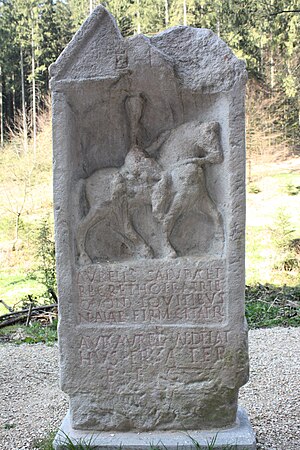Ala Nova company Catafractaria
The Ala Nova company Catafractaria [Philippiana] [milliaria] ( German Ala the new, the reliable of the cataphracts [the Philippian] [1000 men] ) was a Roman auxiliary unit . It is documented by inscriptions.
Name components
- Nova : the new one.
- Company : the strong, powerful, steadfast, reliable, loyal.
- Catafractaria : the cataphract .
- Philippiana : the Philippian. An honorary title that refers to Philip Arabs (244–249). The addition appears in the inscription ( CIL 3, 99 ).
The unit was an ala milliaria . The nominal strength of the Ala was 720 men, consisting of 24 towers with 30 riders each.
history
The Ala was set up by Severus Alexander (222-235) in Mesopotamia and came with him for a planned campaign against Teutons on the Rhine. Under Maximinus Thrax (235-238), the unit fought against the Alemanni and probably moved with him to Italy in 238. She was then probably for the Persian campaign of Gordian III. relocated to the east and was stationed in Arabia Petraea under Philip Arabs .
Locations
Locations of the Ala in Arabia may have been:
- Bostra : The inscription of A. Trebicius Gaudinus was found here.
Members of the Ala
The following members of the Ala are known:
Commanders
Others
See also
Web links
- PANZERREITER AT THE GERMANIC FRONT. www.varusforschung.de, accessed on March 13, 2018 .
Remarks
- ↑ The scenario given here follows the explanations of Ovidiu Țentea, Florian Matei-Popescu and Rainer Wiegels . It assumes that the Ala Nova company Catafractaria is not the same as the Ala I Gallorum et Pannoniorum Catafracta listed in the inscription ( CIL 11, 5632 ). John Spaul , on the other hand, assumes the identity of the two units.
- ↑ The tombstone for Regrethus and Saluda was erected by Abdetathus , the brother (or comrade) of the two. According to Rainer Wiegels , it seems reasonable to assume that Abdetathus was also a rider in the unit.
Individual evidence
- ^ Ovidiu Țentea: Ex Oriente ad Danubium. The Syrian auxiliary units on the Danube frontier of the Roman Empire Publisher: Mega Publishing House, Editor: Center of Roman Military Studies 6, ISBN 978-606-543-206-2 , doi : 10.13140 / RG.2.1.4246.1604 , p. 30-31, 106-107 ( online ).
- ↑ John EH Spaul: Ala. The Auxiliary Cavalry Units of the Pre-Diocletianic Imperial Roman Army. Nectoreca Press, Andover 1994, ISBN 0-9525062-0-3 , pp. 82-84.
- ↑ Rainer Wiegels : On the army formations of Rome on the Rhine and Upper Danube in the time of Severus Alexander and Maximinus Thrax De Gruyter, doi : 10.1515 / klio-2014-0005 , pp. 93-143, here 125-132 ( online ).
